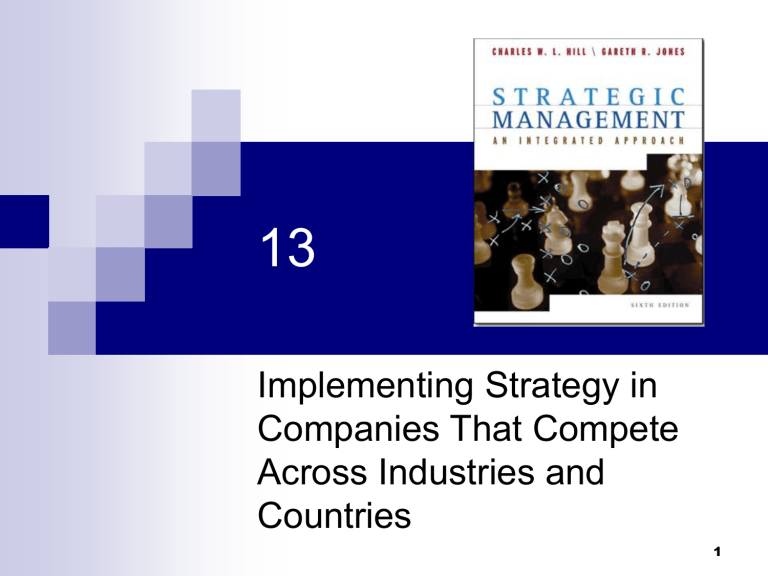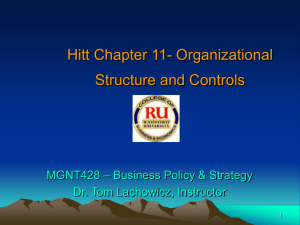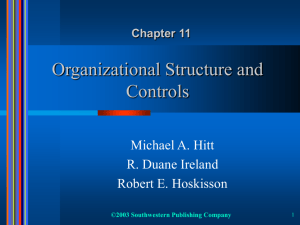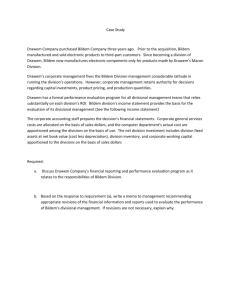Chapter 13 Implementing Strategy in Companies That Compete

13
Implementing Strategy in
Companies That Compete
Across Industries and
Countries
1
Managing Corporate Strategy
Through the Multidivisional Structure
Functional or product structures are not sufficient when a company enters new industries
Multidivisional structure innovations
Divisions (operating responsibility)
Corporate headquarters staff to monitor divisions (strategic responsibility)
Each division may be organized differently
2
Multidivisional Structure
3
Advantages of a Multidivisional
Structure
Enhanced corporate financial control
Enhanced strategic control
Growth
Stronger pursuit of internal efficiency
4
Problems in Implementing a
Multidivisional Structure
Establishing the divisional-corporate authority relationship
Distortion of information
Competition for resources
Transfer pricing
Short-term R&D focus
Duplication of functional resources
5
Structure, Control, Culture, and
Corporate-Level Strategy
Unrelated diversification
Easiest and cheapest strategy to manage
Allows corporate managers to evaluate divisional performance easily and accurately
Divisions have considerable autonomy
No integration among divisions is necessary
6
Structure, Control, Culture, and
CorporateLevel Strategy (cont’d)
Vertical integration
More expensive than unrelated diversification
Multidivisional structure provides necessary controls to achieve benefits from the control of resource transfers
Must strike balance between centralized and decentralized control
Divisions must have input regarding resource transfer
Managed through a combination of corporate and divisional controls
7
Structure, Control, Culture, and
CorporateLevel Strategy (cont’d)
Related diversification
Multidivisional structure allows gains from the transfer, sharing, or leveraging of R&D knowledge, industry information, and customer bases across divisions
Difficult to measure performance of individual divisions
High bureaucratic costs
Integration and control at divisional level is required
Incentives and rewards for cooperation are necessary
8
Corporate Strategy and
Structure and Control
9
The Role of Information
Technology
IT provides a common software platform that can make it less problematic for divisions to share information
IT facilitates output and financial control
IT helps corporate managers react more quickly because of higher-quality, more timely information
IT makes it easier to decentralize control to divisional managers, but react quickly if necessary
IT makes it difficult to distort information because of standardized information
IT eases the transfer pricing problem
10
Implementing Strategy Across
Countries
Multidomestic strategy
Local responsiveness; decentralized control
International strategy
Centralized R&D and marketing; other functions are decentralized
Global strategy
Cost reductions; centralized functions
Transnational strategy
Local responsiveness and cost reduction
11
Global Strategy/Structure
Relationships
12
Implementing a Multidomestic
Strategy
Global-area structure
All value creation activities duplicated and overseas division established in every country of operation
Decentralized authority
Managers at global headquarters evaluate performance of overseas divisions
No integrating mechanisms needed
No global organizational culture
Duplication of specialist activities raises costs
13
Global-Area Structure
14
Implementing International
Strategy
International division structure
Used when a company sells domestically made products in markets abroad
Foreign sales organization added to existing structure; same control system
Customization is minimal
Subsidiary handles local sales and distribution
Behavior controls keep the home office informed
International division coordinates flow of different products across different countries
Domestic and overseas managers may compete for control of strategy making
15
International Division Structure
16
Implementing Global Strategy
Global product-division structure
All value chain activities located to allow efficiency, quality, and innovation
Problems of coordinating and integrating global activities
Structure must lower bureaucratic costs and provide central control
Product division headquarters coordinates activities
17
Global Product-Division Structure
18
Implementing Transnational Strategy
Global Matrix Structure
Lower cost structures and differentiate activities
Decentralized control provides flexibility for local issues, but product and corporate managers at headquarters have centralized control to coordinate company activities on global level
Knowledge and experience can be transferred
Global corporate culture
IT integration mechanisms provide coordination
Bureaucratic costs are high
19
Global Matrix Structure
20
Entry Mode and Implementation
Internal new venturing
Structure, control, and culture must encourage creativity and give intrapreneurs autonomy and freedom to develop and champion new products and allow corporate managers to monitor profitability and fit
Organization-wide new venturing vs. separate new-venture division
21
Entry Mode and Implementation
(cont’d)
Joint venturing
Managing culture differences
Allocating authority and responsibility
Mergers and acquisitions
Must establish new lines of authority
Must streamline operations
In unrelated acquisitions, managers must understand the new industry
Must standardize control systems
Must recognize culture differences
22
IT, the Internet, and Outsourcing
IT and strategy implementation
Knowledge leveraging through IT to achieve low costs and differentiation
Flattening the organization, moving toward decentralization and increased integration through IT
Virtual organization
Knowledge management system
23
IT, the Internet, and Outsourcing
Strategic outsourcing and network structure
IT increases the efficiency of interorganizational relationships
Business-to-business (B2B) networks
Network structure
24




